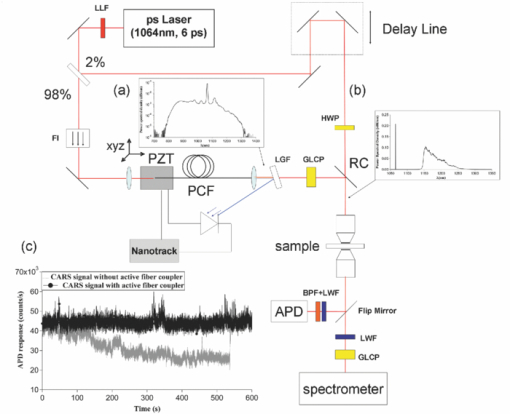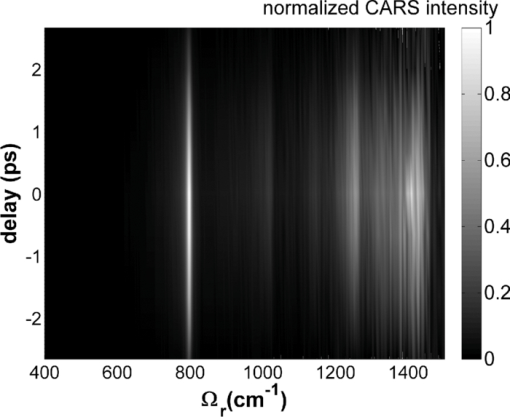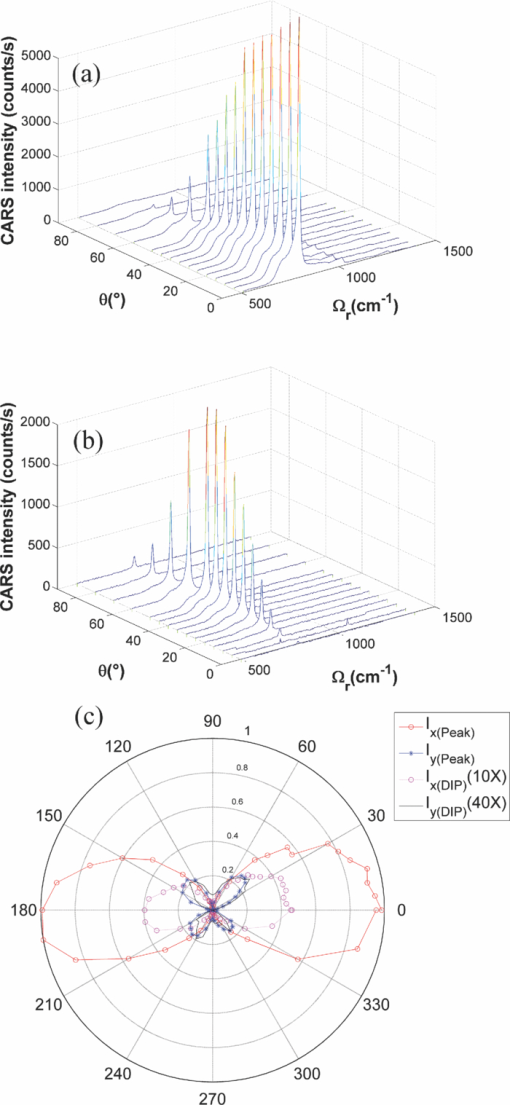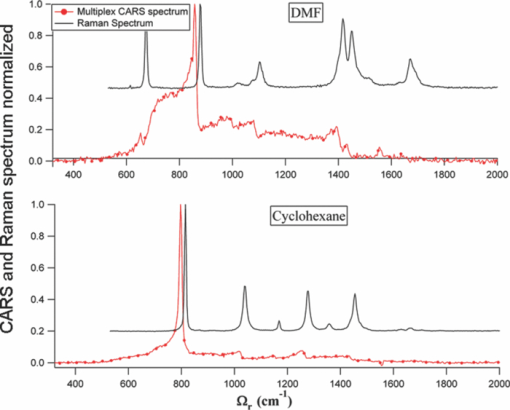|
|
1.IntroductionCoherent anti-Stokes Raman scattering (CARS) is a well-known method used to investigate chemical bonds in a wide range of chemical and biological samples.1, 2 The development of multiplex CARS microscopy has now brought CARS diagnostics to the level of an analytical technique comparable to spontaneous micro-Raman spectroscopy, with the sensitivity of multiplex CARS compatible with practical imaging requirements and acquisition times.3 Several previous studies have demonstrated multiplex CARS using photonic crystal fibers (PCF) to generate a broadband Stokes supercontinuum4, 5, 6 (SC) or a soliton self-frequency shifted Stokes7, 8 that is then recombined with the original pump pulse. The SC generated from these PCFs provides broadband Stokes radiations allowing measurements over a large wavenumber domain.6 A specific and decisive technical advantage in using PCF for CARS measurements is the possibility to generate both pump and Stokes radiations from a single laser oscillator. Because of the extensive previous studies of SC generation using femtosecond pump pulses, multiplex CARS measurements with PCF are also typically performed in this regime but this scheme limits the attainable spectral resolution unless narrowband spectral filtering (with power reduction) is applied to the pump beam. There are several advantages in working in the ps regime that not solely include the achievable spectral resolution in CARS but also greatly simplify the laser system as compared to conventional Ti:Saph lasers. Picosecond lasers based on Nd3+ doped gain media can be diode pumped, are readily commercially available, relatively inexpensive, and often very compact. Combined with PCF such ps Nd3+ lasers can be arranged in a compact reliable source for CARS spectroscopy and microscopy. Here, we report an approach to high resolution and stable multiplex CARS measurements using a PCF-generated SC from a picosecond pump laser. Our results extend earlier proof-of-principle picosecond CARS measurements9, 10 through first, the use of active coupling that ensures a CARS power stabilization and second, a polarization beam control. With our setup, we obtain micro-spectroscopic measurements in the 600–2000 cm−1 spectral range and polarization resolved multiplex CARS measurement to extract the CARS spectroscopic parameters of DMF and Cyclohexane test samples. 2.Experimental Set-up and ResultsFigure 1 shows our multiplex CARS setup. A custom-built Nd3+:Vanadate laser (Amplitude Systemes) is used as a pump source. The temporal duration, pulse energy, repetition rate, and peak wavelength are 6 ps, 78 nJ, 34.5 MHz, and 1064 nm, respectively. Fig. 1Experimental setup for broadband multiplex CARS measurement, PCF: photonic crystal fiber, PZT: active fiber coupler, LLF: laser line filter (Semrock LL01–1064-12.5), FI: Faraday isolator (EOT 1030–1080 nm); BPF: band pass filter (Thorlabs FB980–10); LWF: lowpass wavelength filter (Thorlabs FES1000); LGF: longpass wavelength filter (Thorlabs FEL1150), GLCP: Glan-laser calcite polarizer (Thorlabs), HWP: half-wave plate, RC: recombination mirror (Thorlabs FEL1100). Insets: (a) SC spectrum (log scale); (b) pump and stokes spectra as sent on the sample (linear scale); (c) CARS signal stability with and without the active fiber coupler (gray and black lines, respectively).  The output beam is separated into two parts using a BK7 window. The main part (typically 98%) is coupled into a 1 m highly nonlinear PCF (NKT Photonics SC-5.0–1040) for SC generation. A longpass wavelength filter (LGF), is thereafter used to obtain the Stokes beam (1150–1250 nm). An active xyz piezoelectric system (Nanotrack Thorlabs) optimizes in real time the laser coupling into the PCF, based on a feedback signal from the SC power reflected by the LGF. This reflected beam (750–1150 nm – 100 mW) is sent directly on the feedback photodiode with a target point regulation that aims at maximizing this reflection, and thus the output SC power. The resulting energies for the pump and the spectrally filtered Stokes beams are 3 nJ (105 mW) and 2 nJ (70 mW), respectively. Two microscope objectives are then used to illuminate the liquid sample and to collect the CARS signal. The numerical apertures for illumination and collection are NA = 0.6 and NA = 0.45, respectively. The sample is contained in a glass dish with a path length of 10 mm. The CARS signal is detected either with an avalanche photodiode or a high sensitivity spectrometer (OCEAN Optics QE65000). In order to reject the pump and the Stokes radiations, a combination of lowpass wavelength and bandpass filters are placed before the detection lines. In a first experiment intended to collect the CARS multiplex spectra we remove the polarization optics [half-wave plate (HWP) on pump beam and GLCP on Stokes beam – see Fig. 1] both on the pump and Stokes beams. For SC generated in PCF, the different spectral components are usually well temporally-separated and it is required to carefully scan the delay between the pump and Stokes beams to measure the full available CARS spectrum.4, 6, 11 Interestingly in our configuration, we checked that the zero delay value could give the optimal CARS spectrum for the whole frequency range (i.e., 600–2000 cm−1) without need for delay tuning. The delay insensitivity arises because of the comparable temporal durations of the Stokes and pump pulses used in our experiments in the picosecond duration.11 Significantly, with no delay adjustment, our multiplex CARS setup is sensitive to the wavenumber range 600–2000 cm−1 with a high degree of CARS signal stability [see inset (c) in Fig. 1]. This wavenumber independent CARS spectrum (in the pump and Stokes beams overlapping range) is shown in Fig. 2, where we measure the CARS signal with the spectrometer for several delay values between the pump and Stokes pulses. Note that Fig. 2 has been renormalized in the high wavenumber range to enhance the visibility of the peaks higher than 1000 cm−1. Fig. 2Effect of the delay between the pump and Stokes pulses in CARS measurement for Cyclohexane. In the whole spectral range available, the different resonances appear for a delay value equal to zero (for the visibility of this mapping, the same exponential function was applied on each obtained spectra corresponding to a specific delay. This permits the enhancement of the brightness of the peaks values in the high wavenumber range).  We performed CARS measurements on cyclohexane and dimethylformamide (DMF) liquid samples over the wavenumber range 600–2000 cm−1, the spectrometer collects the CARS signal between 870 and 1000 nm with an integration time of 60 s. Figure 3 shows the experimentally obtained multiplex CARS signals and their respective Raman spectra (offset for clarity). The Raman spectra are measured with a custom made Raman micro-spectrometer. For the CARS spectra shown here, we subtracted the noise of the spectrometer. This noise is evaluated when the pump and Stokes pulses are not temporally overlapped. Therefore, these spectra correspond to the pure CARS response of the liquids, with the resonant and nonresonant parts. The incoming pump and Stokes power were 105 and 70 mW, respectively. As previously reported, the CARS maxima are shifted toward the lower frequencies with respect to the Raman maxima. We note that for cyclohexane, the resonances for frequencies larger than 800 cm−1 are clearly visible, even though their intensities are very low.12 As expected, the CARS spectra show a “peak-dip” shape around the Raman resonances. 3.Polarized multiplex CARS spectra: dependence with polarization StatesWe now consider on the polarization dependence of the CARS spectra when the pump and Stokes beams have different linear polarization states. Although we use a linearly polarized pump beam, the SC is unpolarized as no special precaution is taken to identify or exploit residual PCF birefringence to ensure polarization-maintaining injection. We have recently shown in Ref. 13 that the Raman depolarization ratio ρ R, the resonant versus nonresonant contributions [TeX:] $\frac{a}{{\chi _{NR}^{(3)} \Gamma }}$ (where a is the resonance strength and χ (3) (NR) the nonresonant tensor13), and the Raman resonance frequency Ω R and linewidth Γ could be obtained when the pump and Stokes linearly polarized states were prepared with at a relative angle of 45 deg. This measurement technique is based on analyzing the CARS signal in polarization both at peak and dip spectral points. To achieve such a scheme with our multiplex CARS spectrum, we add a Glan-laser calcite polarizer (GLCP on Stokes beam in Fig. 1) at the PCF exit in order to set a clear linear polarization state along the X axis for the Stokes SC beam. In addition a HWP allows rotation of the linear polarization state of the pump beam (HWP on pump beam in Fig. 1). Finally, a polarizing beam splitter is used to detect either the CARS spectrum along the X axis (I X) or along the Y axis (I Y) (not shown in Fig. 1). Figure 4 plots the I X and I Y CARS spectra for a cyclohexane solution as a function of the pump-Stokes polarization angle θ. I X is maximized when the pump and Stokes polarization states are parallel (i.e., θ = 0). For I Y, the maximum is reached when θ = 45 deg.13 A detailed plot of the θ-dependence at the “peak” and “dip” frequency shifts is shown in the polar plots in Fig. 4(c). As demonstrated in Ref. 13, these polarization-resolved spectra then allow complete characterization of the spectroscopic CARS parameters for the liquid under study, and Table 1 shows these results obtained for cyclohexane and DMF (labeled “Exp.”). Comparison with previous results,14, 15 spontaneous Raman measurements Ref. 16, and available database values17 is also given in Table 1 (labeled “Ref.”). Fig. 4Polarized CARS spectra for cyclohexane solution measured along the (a) X and (b) Y axis when the angle θ between the pump and Stokes beam is varied. (c) CARS intensity at the peak and dip spectral points along the X and Y axis.  Table 1CARS spectroscopic parameters for cyclohexane and DMF evaluated from the polarized CARS analysis. $\frac{a}{{\chi _{NR}^{(3)} \Gamma }}$ aχNR(3)Γ resonant versus nonresonant contributions,13 ρR Raman depolarization ratio, ΩR Raman resonance frequency, Γ Raman resonance frequency linewidth. Available corresponding data from the literature (namely Refs. 12–15) are also given. 4.ConclusionIn conclusion, we have described a broadband, compact, and stable system for multiplex CARS micro-spectroscopy based on a ps laser source and a SC generated in a nonlinear PCF. This setup generates polarization-resolved CARS multiplex spectra from which we have extracted the CARS spectroscopic parameters in the 600–2000 cm−1 spectral range for two test liquids. This analysis could be further extended to imaging using a similar setup with a raster scanning unit. We believe polarization resolved multiplex CARS will become an invaluable technique for determining information on molecular orientation such as polarized micro-Raman. AcknowledgmentsThis work is supported and funded by the French National Research Agency, ANR program RIB SOFICARS and EU FP7 CARSExplorer Grant Health 2007 1.2-2. ReferencesA. Volkmer,
“Vibrationnal imaging and microspectroscopies based on coherent anti-Stokes Raman scattering microscopy,”
J. Phys. D: Appl. Phys., 38 R59
–R81
(2005). https://doi.org/10.1088/0022-3727/38/5/R01 Google Scholar
A. Zumbusch, G. Holtom, and
X. Xie,
“Three-dimensional vibrational imaging by coherent anti-Stokes Raman scattering,”
Phys. Rev. Lett., 82 4142
–4145
(1999). https://doi.org/10.1103/PhysRevLett.82.4142 Google Scholar
M. Muller and
J. M. Schins,
“Imaging the thermodynamic state of lipid membranes with multiplex CARS microscopy,”
J. Phys. Chem. B, 106 3715
–3723
(2002). https://doi.org/10.1021/jp014012y Google Scholar
H. Kano and
H.-O. Hamaguchi,
“Characterization of a supercontinuum generated from a photonic crystal fiber and its application to coherent Raman spectroscopy,”
Opt. Lett., 28 2360
–2362
(2003). https://doi.org/10.1364/OL.28.002360 Google Scholar
H. Paulsen, K. Hilligsoe, J. Thogersen, S. Keiding, and
J. Larsen,
“Coherent anti-Stokes Raman scattering microscopy with a photonic crystal fiber based light source,”
Opt. Lett., 28 1123
–1125
(2003). https://doi.org/10.1364/OL.28.001123 Google Scholar
H. Kano and
H. Hamaguchi,
“Ultrabroadband (>2500cm-1) multiplex coherent anti-Stokes Raman scattering microspectroscopy using a supercontinuum generated from a photonic crystal fiber,”
Appl. Phys. Lett., 86 121113
(2005). https://doi.org/10.1063/1.1883714 Google Scholar
E. Andresen, V. Birkedal, J. Thogersen, and
S. Keiding,
“Tunable light source for coherent anti-Stokes Raman scattering microspectroscopy based on the soliton self-frequency shift,”
Opt. Lett., 31 1328
–1330
(2006). https://doi.org/10.1364/OL.31.001328 Google Scholar
D. Sidorov-Biryukov, E. Serebryannikov, and
A. Zheltikov,
“Time-resolved coherent anti-Stokes Raman scattering with a femtosecond soliton output of a photonic-crystal fiber,”
Opt. Lett., 31 2323
–2325
(2006). https://doi.org/10.1364/OL.31.002323 Google Scholar
G. Petrov and
V. Yakovlev,
“Enhancing red-shifted white-light continuum generation in optical fibers for applications in nonlinear Raman microscopy,”
Opt. Express, 13 1299
–1306
(2005). https://doi.org/10.1364/OPEX.13.001299 Google Scholar
R. Arora, G. Petrov, and
V. Yakovlev,
“Analytical capabilities of coherent anti-Stokes Raman scattering microspectroscopy,”
J.Mod. Opt., 55 3237
–3254
(2008). https://doi.org/10.1080/09500340802168639 Google Scholar
J. Dudley, G. Genty, and
S. Coen,
“Supercontinuum generation in photonic crystal fiber,”
Rev. Mod. Phys., 78 1135
–1184
(2006). https://doi.org/10.1103/RevModPhys.78.1135 Google Scholar
B. N. Toleutaev, T. Tahara, and
H. Hamaguchi,
“Broadband (1000 cm−1) multiplex CARS spectroscopy: Application to polarization sensitive and time-resolved measurements,”
Appl. Phys. B, 59 369
–375
(1994). https://doi.org/10.1007/BF01081059 Google Scholar
F. Munhoz, S. Brustlein, D. Gachet, F. Billard, S. Brasselet, and
H. Rigneault,
“Raman depolarization ratio of liquids probed by linear polarization coherent anti-Stokes Raman spectroscopy,”
J. Raman Spectrosc., 40 775
–780
(2009). https://doi.org/10.1002/jrs.v40:7 Google Scholar
V. L. Furer and
V. V. Alekseev,
“Study of the intensities of the bands in the Raman spectra of amides,”
J. Appl. Spectrosc., 45 1281
–1284
(1986). https://doi.org/10.1007/BF00659741 Google Scholar
M. Pelletier,
“Effects of temperature on cyclohexane Raman bands,”
Appl. Spectrosc., 53 1087
–1096
(1999). https://doi.org/10.1366/0003702991947865 Google Scholar
We use a custom made Raman microscope to evaluate the Raman resonances and their FWHM corresponding. Google Scholar
“Spectral Database for Organic Compounds, SDBS,”
(1999) http://riodb01.ibase.aist.go.jp/sdbs/cgi-bin/direct_frame_top.cgi Google Scholar
|


